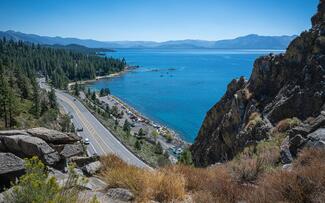Plans for a “flying” electric ferry on Lake Tahoe, expected to carry up to 300 passengers per day at a cost of $50 each way, have sparked questions about whether such a service would meaningfully reduce area traffic and serve local commuters.
The proposed hydrofoil ferry, intended to cut travel times between the north and south shores of Lake Tahoe, aims to begin service as soon as late 2025 or early 2026, according to FlyTahoe founder and CEO Ryan Meinzer. While the technology could offer scenic rides above the water’s surface and reduce wake-related shoreline erosion, critics say the plan does not address the region’s primary transportation challenges.
Local transportation advocates point to the nearly 20,000 vehicles traveling the lake’s north-south corridor each day. They say the ferry’s capacity—300 passengers—would amount to “a drop in the ocean” compared with daily road traffic.
“Even if these ferries run at full capacity every day, that’s a fraction of the total number of vehicles we see,” said one Tahoe-area resident who commutes by car and requested anonymity due to ongoing public discourse about the project. “We need solutions that are accessible, affordable and used by year-round residents, not just tourists.”
At $50 each way, a round trip on the ferry would cost $100, a price many observers argue is out of reach for most workers in the region. They say those who commute daily or need to travel between multiple local points throughout the day would likely find driving more practical than paying high ferry fares.
“This feels more like a tourist attraction than a serious fix,” said an anonymous local resident who supports sustainability efforts in Tahoe-Truckee. “I’d rather see money put into better bike paths in our neighborhoods and improved bus or shuttle services. Those are more realistic and cost-effective ways to cut down on traffic and protect the lake.”
Meanwhile, area authorities, including the Tahoe Regional Planning Agency, say they continue to support projects that can take cars off the road. However, no official applications for the ferry service had been submitted as of this week.
Critics also question the agency’s emphasis on a pedestrian and bike path around the lake’s 72-mile perimeter, arguing that such a project offers recreational benefits but does little for day-to-day commuting. Instead, they favor improved in-town pathways and public transit routes that connect residents to workplaces, schools and shopping centers.
Meinzer, who acknowledged the steep cost for travelers, said the initial ferry could be the first of several and that expanded service might offer better economies of scale. He added that regulatory hurdles, including the Jones Act, which requires vessels traveling between U.S. ports to be built domestically, would affect the ferry’s timeline and budget.
Local groups continue to advocate for more immediate measures—such as enhanced bus routes, ride-sharing programs and robust cycling infrastructure—as cost-effective steps to relieve congestion and protect Tahoe’s famous cobalt-blue waters.


